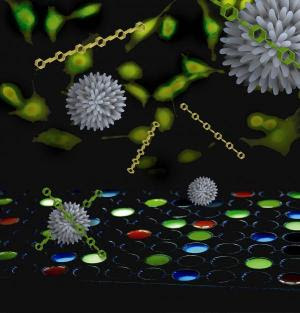
Using a “chemical nose” array of nanoparticles and polymers, researchers at the University of Massachusetts Amherst have developed a fundamentally new, more effective way to differentiate not only between healthy and cancerous cells but also between metastatic and non-metastatic cancer cells. It’s a tool that could revolutionize cancer detection and treatment, according to chemist Vincent Rotello and cancer specialist Joseph Jerry.An article describing Rotello and colleagues’ new chemical nose method of cancer detection appears in the June 23 issue of the journal Proceedings of the National Academy of Sciences online.
Currently, detecting cancer via cell surface biomarkers has taken what’s known as the “lock and key” approach. Drawbacks of this method include that foreknowledge of the biomarker is required. Also, as Rotello explains, a cancer cell has the same biomarkers on its surface as a healthy cell, but in different concentrations, a maddeningly small difference that can be very difficult to detect. “You often don’t get a big signal for the presence of cancer,” he notes. “It’s a subtle thing.”
He adds, “Our new method uses an array of sensors to recognize not only known cancer types, but it signals that abnormal cells are present. That is, the chemical nose can simply tell us something isn’t right, like a ‘check engine light,’ though it may never have encountered that type before.” Further, the chemical nose can be designed to alert doctors of the most invasive cancer types, those for which early treatment is crucial.
In blinded experiments in four human cancer cell lines (cervical, liver, testis and breast), as well as in three metastatic breast cell lines, and in normal cells, the new detection technique correctly indicated not only the presence of cancer cells in a sample but also identified primary cancer vs. metastatic disease.
In further experiments to rule out the possibility that the chemical nose had simply detected individual differences in cells from different donors, the researchers repeated the experiments in skin cells from three groups of cloned BALB /c mice: healthy animals, those with primary cancer and those with metastatic disease. Once again, it worked. “This result is key,” says Rotello. “It shows that we can differentiate between the the three cell types in a single individual using the chemical nose approach.”
Rotello’s research team, with colleagues at the Georgia Institute of Technology, designed the new detection system by combining three gold nanoparticles that have special affinity for the surface of chemically abnormal cells, plus a polymer known as PPE, or para-phenyleneethynylene. As the ‘check engine light,’ PPE fluoresces or glows when displaced from the nanoparticle surface.
By adding PPE bound with gold nanoparticles to human cells incubating in wells on a culture plate, the researchers induce a response called “competitive binding.” Cell surfaces bind the nanoparticles, displacing the PPE from the surface. This turns on PPE’s fluorescent switch. Cells are then identified from the patterns generated by different particle-PPE systems.
Rotello says the chemical nose approach is so named because it works like a human nose, which is arrayed with hundreds of very selective chemical receptors. These bind with thousands of different chemicals in the air, some more strongly than others, in the endless combination we encounter. The receptors report instantly to the brain, which recognizes patterns such as, for example, “French fries,” or it creates a new smell pattern.
Chemical receptors in the nose plus the brain’s pattern recognition skills together are incredibly sensitive at detecting subtly different combinations, Rotello notes. We routinely detect the presence of tiny numbers of bacteria in meat that’s going bad, for instance. Like a human nose, the chemical version being developed for use in cancer also remembers patterns experienced, even if only once, and creates a new one when needed.
For the future, Rotello says further studies will be undertaken in an animal model to see if the chemical nose approach can identify cell status in real tissue. Also, more work is required to learn how to train the chemical nose’s sensors to give more precise information to physicians who will be making judgment calls about patients’ cancer treatment. But the future is promising, he adds. “We’re getting complete identification now, and this can be improved by adding more and different nanoparticles. So far we’ve experimented with only three, and there are hundreds more we can make.”
INTERNAL MEDICINE The internal medicine blog , where you can have details on alternatice medicine , latest trends in medicine , new drugs in the market , school of medicine etc
‘Chemical Nose’ May Sniff Out Cancer Earlier
Wednesday, June 24, 2009 at 12:58 AM Posted by Sajith
Autonomous Robot Detects Shrapnel In Flesh
at 12:54 AM Posted by Sajith
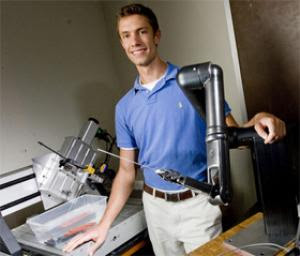
Bioengineers at Duke University have developed a laboratory robot that can successfully locate tiny pieces of metal within flesh and guide a needle to its exact location -– all without the need for human assistance.The successful proof-of-feasibility experiments lead the researchers to believe that in the future, such a robot could not only help treat shrapnel injuries on the battlefield, but might also be used for such medical procedures as placing and removing radioactive "seeds" used in the treatment of prostate and other cancers.
In their latest experiments, the engineers started with a rudimentary tabletop robot whose "eyes" are a novel 3-D ultrasound technology developed at Duke. An artificial intelligence program served as the robot's "brain" by taking the real-time 3-D information, processing it and giving the robot specific commands to perform. In their simulations, the researchers used tiny (2 millimeter) pieces of needle because, like shrapnel, they are subject to magnetism.
"We attached an electromagnet to our 3-D probe, which caused the shrapnel to vibrate just enough that its motion could be detected," said A.J. Rogers, who just completed an undergraduate degree in bioengineering at Duke. "Once the shrapnel's coordinates were established by the computer, it successfully guided a needle to the site of the shrapnel."
By proving that the robot could guide a needle to an exact location, it would simply be a matter of replacing the needle probe with a tiny tool, such as a grabber, the researchers said.
Rogers worked in the laboratory of Stephen Smith, director of the Duke University Ultrasound Transducer Group and senior member of the research team. The results of the experiments were published early online in the July issue of the journal IEEE Transactions on Ultrasonics, Ferroelectrics and Frequency Control.
Since the researchers achieved positive results using a rudimentary robot and a basic artificial intelligence program, they are encouraged that simple and reasonably safe procedures will become routine in the near future as robot and artificial intelligence technology improves.
"We showed that in principle, the system works," Smith said. "It can be very difficult using conventional means to detect small pieces of shrapnel, especially in the field. The military has an extensive program of exploring the use of surgical robots in the field, and this advance could play a role."
In addition to its applications recovering the radioactive seeds used in treating prostate cancer, Smith said the system could also prove useful in removing foreign, metallic objects from the eye.
Advances in ultrasound technology have made these latest experiments possible, the researchers said, by generating detailed, 3-D moving images in real-time. The Duke team has a long track record of modifying traditional 2-D ultrasound – like that used to image babies in utero – into the more advanced 3-D scans. Since inventing the technique in 1991, the team has shown its utility by developing specialized catheters and endoscopes for real-time imaging of blood vessels in the heart and brain.
In the latest experiments, the robot successfully performed its main task: locating a tiny piece of metal in a water bath, then directing a needle on the end of the robotic arm to it. The researchers had previously used this approach to detect micro-calcifications in simulated breast tissue. In the latest experiments, Rogers added an electromagnet to the end of the transducer, or wand, the device that sends out and receives the ultrasonic waves.
"The movement caused by the electromagnet on the shrapnel was not visible to the human eye," Rogers said. "However, on the 3-D color Doppler system, the moving shrapnel stood out plainly as bright red."
The robot used in these experiments is a tabletop version capable of moving in three axes. For the next series of tests, the Duke researchers plan to use a robotic arm with six-axis capability.
The research in Smith's lab is supported by the National Institutes of Health. Duke's Ned Light was also part of the research team.
1.02 Billion People Hungry: One Sixth Of Humanity Undernourished, More Than Ever Before
Saturday, June 20, 2009 at 3:38 AM Posted by Sajith

World hunger is projected to reach a historic high in 2009 with 1,020 million people going hungry every day, according to new estimates published by United Nation's Food and Agriculture Organization (FAO).The most recent increase in hunger is not the consequence of poor global harvests but is caused by the world economic crisis that has resulted in lower incomes and increased unemployment. This has reduced access to food by the poor, the UN agency said.
"A dangerous mix of the global economic slowdown combined with stubbornly high food prices in many countries has pushed some 100 million more people than last year into chronic hunger and poverty," said FAO Director-General Jacques Diouf. "The silent hunger crisis — affecting one sixth of all of humanity — poses a serious risk for world peace and security. We urgently need to forge a broad consensus on the total and rapid eradication of hunger in the world and to take the necessary actions."
"The present situation of world food insecurity cannot leave us indifferent," he added.
Poor countries, Diouf stressed, "must be given the development, economic and policy tools required to boost their agricultural production and productivity. Investment in agriculture must be increased because for the majority of poor countries a healthy agricultural sector is essential to overcome poverty and hunger and is a pre-requisite for overall economic growth."
"Many of the world's poor and hungry are smallholder farmers in developing countries. Yet they have the potential not only to meet their own needs but to boost food security and catalyse broader economic growth. To unleash this potential and reduce the number of hungry people in the world, governments, supported by the international community, need to protect core investments in agriculture so that smallholder farmers have access not only to seeds and fertilisers but to tailored technologies, infrastructure, rural finance, and markets," said Kanayo F. Nwanze, President of the International Fund for Agricultural Development (IFAD).
"For most developing countries there is little doubt that investing in smallholder agriculture is the most sustainable safety net, particularly during a time of global economic crisis," Nwanze added.
"The rapid march of urgent hunger continues to unleash an enormous humanitarian crisis. The world must pull together to ensure emergency needs are met as long term solutions are advanced," said Josette Sheeran, Executive Director of the UN World Food Programme.
Hunger on the rise
Whereas good progress was made in reducing chronic hunger in the 1980s and the first half of the 1990s, hunger has been slowly but steadily on the rise for the past decade, FAO said. The number of hungry people increased between 1995-97 and 2004-06 in all regions except Latin America and the Caribbean. But even in this region, gains in hunger reduction have been reversed as a result of high food prices and the current global economic downturn.
This year, mainly due to the shocks of the economic crisis combined with often high national food prices, the number of hungry people is expected to grow overall by about 11 percent, FAO projects, drawing on analysis by the U.S. Department of Agriculture.
Almost all of the world's undernourished live in developing countries. In Asia and the Pacific, an estimated 642 million people are suffering from chronic hunger; in Sub-Saharan Africa 265 million; in Latin America and the Caribbean 53 million; in the Near East and North Africa 42 million; and in developed countries 15 million in total.
In the grip of the crisis
The urban poor will probably face the most severe problems in coping with the global recession, because lower export demand and reduced foreign direct investment are more likely to hit urban jobs harder. But rural areas will not be spared. Millions of urban migrants will have to return to the countryside, forcing the rural poor to share the burden in many cases.
Some developing countries are also struggling with the fact that money transfers (remittances) sent from migrants back home have declined substantially this year, causing the loss of foreign exchange and household income. Reduced remittances and a projected decline in official development assistance will further limit the ability of countries to access capital for sustaining production and creating safety nets and social protection schemes for the poor.
Unlike previous crises, developing countries have less room to adjust to the deteriorating economic conditions, because the turmoil is affecting practically all parts of the world more or less simultaneously. The scope for remedial mechanisms, including exchange-rate depreciation and borrowing from international capital markets for example, to adjust to macroeconomic shocks, is more limited in a global crisis.
The economic crisis also comes on the heel of the food and fuel crisis of 2006-08. While food prices in world markets declined over the past months, domestic prices in developing countries came down more slowly. They remained on average 24 percent higher in real terms by the end of 2008 compared to 2006. For poor consumers, who spend up to 60 percent of their incomes on staple foods, this means a strong reduction in their effective purchasing power. It should also be noted that while they declined, international food commodity prices are still 24 percent higher than in 2006 and 33 percent higher than in 2005.
The 2009 hunger report (The State of Food Insecurity in the World, SOFI) will be presented in October.
Key Found To How Tumor Cells Invade The Brain In Childhood Cancer
at 3:31 AM Posted by Sajith

Despite great strides in treating childhood leukemia, a form of the disease called T-cell acute lymphoblastic leukemia (T-ALL) poses special challenges because of the high risk of leukemic cells invading the brain and spinal cord of children who relapse.Now, a new study in the June 18, 2009, issue of the journal Nature by scientists at NYU School of Medicine reveals the molecular agents behind this devastating infiltration of the central nervous system. The finding may lead to new drugs that block these agents and thus lower the risk of relapse.
T-ALL, a blood-borne cancer in which the bone marrow makes too many lymphocytes, or white blood cells, strikes several hundred children and adolescents in the U.S. annually. While greater than 90% percent go into remission through a combination of chemotherapy and radiation, up to one third of this group end up relapsing. These patients are at particular risk for tumor cells to invade the brain and spinal cord, and to prevent this all patients receive chemotherapy injections into the central nervous system and in some cases cranial irradiation—approaches that cause dangerous side effects, including secondary tumors and potentially permanent cognitive and developmental deficits.
“In general, T-cell acute lymphoblastic leukemia is treatable with chemotherapy and radiation,” said Ioannis Aifantis, PhD, associate professor of pathology and co-director of the Cancer Stem Cell Program at the NYU Cancer Institute, who led the new study. “But you have a very high rate of relapse. And after the relapse, it is not treatable because the cancer occurs in tricky places like the central nervous system,” said Dr. Aifantis, who is also an Early Career Scientist at the Howard Hughes Medical Institute.
“We are very proud of this research and very excited about the potential implications for new therapeutic approaches to prevent or reduce the spread of leukemic cells into the central nervous system,” said Vivian S. Lee MD, PhD, MBA, the vice dean for science, senior vice president and chief scientific officer of NYU Langone Medical Center.
In the new study, Dr. Aifantis and his colleagues found that a key protein receptor embedded on the outer surface of leukemic cells is responsible for infiltrating the brain and spinal cord. “What we have found is that leukemic cells over-express this receptor.” said Dr. Aifantis, “If you knock out this receptor, these cells will not go to the brain under any circumstances.”
Previous research had strongly implicated a famous gene regulator called Notch1 in the progression of T-ALL. The Notch1 gene (a mutated version gives fruit flies notched wings) is an oncogene, or cancer-causing gene, in humans. Certain kinds of mutations in this gene have been found in nearly half of all T-ALL patients, and current estimates suggest that the gene’s regulatory influence might be implicated in nearly 90 percent of all T-ALL cases.
For their new study, Dr. Aifantis and his colleagues first introduced overactive forms of Notch1 into mice. As a result, the mice developed leukemia and the leukemic cells efficiently infiltrated the inner layers of the membrane covering the brain. “What happens is that the leukemic cells get into the cerebrospinal fluidthat protects our brain and spine, where they fill up the space and they can affect brain function, either by secreting chemicals and toxic factors or even by simple pressure,” Dr. Aifantis said.
His team then examined an array of other mouse genes to identify candidates that might fall under the regulatory spell of Notch1 to promote the brain and spinal cord infiltration. The screen revealed a promising gene for a protein named CCR7, which is embedded on the surface of lymphocytes. This chemokine receptor, as it’s known, normally senses and responds to small chemical attractants called chemokines, which act like recruitment signals for lymphocytes to converge on a specific site during the body’s response to infection or injury. In leukemia, however, these lymphocytes proliferate abnormally.
CCR7 was already known as a key player in normal lymphocyte migration and as a binding partner of two chemokines named CCL19 and CCL21. Previous studies had implicated these protein interactions in the metastasis of other tumors such as melanomas and breast cancers. Dr. Aifantis’s team also discovered that the gene for CCR7 was overactive in four of five T-ALL cell lines derived from human patients, bolstering suspicions that it played a central role in the disease. Conversely, a mutation that knocked out Notch1 also led to dramatically reduced CCR7 levels.
To characterize CCR7’s potential role in T-ALL, the researchers used two sets of mice: one in which the receptor was turned on, and a second in which it was turned off. When the team delivered an identical number of human-derived leukemic cells to both sets of mice, those with the CCR7 chemokine receptor turned off lived almost twice as long. Using bioluminescent imaging, the researchers quickly understood why: animals with the active CCR7 receptor had many more tumors. Tellingly, the T-ALL cells had infiltrated the brain and spinal cord of those mice.
Further experiments suggested that when healthy mice received leukemic cells in which the gene for CCR7 had been turned off, the cells could not migrate to the brain even though they reached other body tissues. As a result, the mice survived significantly longer than counterparts with an active copy of the gene. On the other hand, introducing a normal version of the same gene to mice otherwise lacking it was enough to recruit leukemic cells to the brain and spine.
“We wanted to determine whether CCR7 by itself was sufficient for entry into the central nervous system and that’s what this experiment shows,” Dr. Aifantis said. “By changing one specific gene, you now have your function back.”
Finally, the researchers identified the small protein that acted as the “come hither” signal for the CCR7 protein receptors. One candidate, CCL21, was undetectable in leukemic mice. But a second, CCL19, appeared in tiny veins of the brain near the infiltrating tumor cells. When the researchers introduced leukemic cells carrying a gene for CCR7 to mice that naturally lacked the CCL19 chemokine, the mice survived longer, suggesting that their increased life spans might be due to a disrupted interaction of the two proteins. The leukemic cells had no trouble infiltrating other tissue like the lymph nodes, but were completely incapable of infiltrating the brains of CCL19-deficient mice, the researchers report.
“Perhaps there are antibodies or small molecules that can block the interaction between these two proteins or reduce their interactions,” Dr. Aifantis said, “and hopefully that could be used as a type of prophylactic treatment to prevent a relapse in the central nervous system among patients who have already been treated for leukemia.” Such a treatment, he said, could prove a good alternative to the intensive and often poorly tolerated radiation and chemotherapy now used to try to block such a relapse.
The study was led by Dr. Silvia Buonamici, a post-doctoral fellow in the laboratory of Dr. Aifantis in the Department of Pathology and the NYU Cancer Institute, and in the Helen L. and Martin S. Kimmel Stem Cell Center at NYU Langone Medical Center. Other study investigators are; Thomas Trimarchi, Maria Grazia Ruocco, Linsey Reavie, Severine Cathelin, Yevgeniy Lukyanov, Jen-Chieh Tseng, Filiz Sen, Mengling Li, Elizabeth Newcomb, Jiri Zavadil, Daniel Meruelo, Sherif Ibrahim, David Zagzag, and Michael L. Dustin from NYU Langone Medical Center; Brenton G. Mar, Apostolos Klinakis, and Argiris Efstratiadis from Columbia University Medical Center; Eric Gehrie and Jonathan S. Bromberg from Mount Sinai School of Medicine; and Martin Lipp from the Max Delbrück Center for Molecular Medicine in Berlin.
The study was supported by grants from the National Institutes of Health, the American Cancer Society, the Dana Foundation, The Chemotherapy Foundation, the Alex’s Lemonade Stand Foundation, the Lauri Strauss Leukemia foundation, the G&P Foundation, an NYU School of Medicine Molecular Oncology and Immunology training grant, the American Society of Hematology, the Juvenile Diabetes Research Foundation, the National Cancer Institute, a gift from the Berrie Foundation, and a fellowship from the Jane Coffin Childs Memorial Fund for Medical Research.
One more swine flu case; India says US should screen passengers
Wednesday, June 17, 2009 at 3:44 AM Posted by Sajith
A nine-year-old boy on Tuesday tested positive for swine flu taking the total number of cases to 31 in the country even as the govt said the US should "suo motu" start screening outbound passengers for symptoms of the disease.
New Delhi has also asked the developed countries to take action to contain and check the spread of swine flu at their end which would help stop the spread of the infection to the developing nations.
The fresh case was reported from Hyderabad where the boy arrived on 14th June from from New Jersey via London. "He has tested positive. He is on treatment. All his contacts are being traced," a Health Ministry official said.
Three passengers, including a staffer of a leading international airlines, have been quarantined at a hospital in Bangalore while a 22-year-old passenger was hospitalised in Kochi with symptoms of swine flu.
Of the 31 cases, 11 have been discharged. Rest of the passengers are all stable, the official said.
With mounting cases of swine flu in people coming from US, the Health Ministry said the US should "suo motu" start screening outbound passengers for symptoms of the disease.
Minister of State for Health and Family Welfare Dinesh Trivedi said the US is the "main source" of the virus for India with many travellers from that country testing positive for the flu.
New Nanoparticles Could Lead To End Of Chemotherapy
at 3:35 AM Posted by Sajith
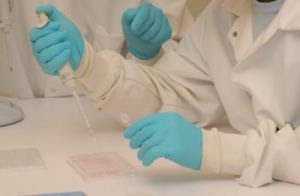
Nanoparticles specially engineered by University of Central Florida Assistant Professor J. Manuel Perez and his colleagues could someday target and destroy tumors, sparing patients from toxic, whole-body chemotherapies.Perez and his team used a drug called Taxol for their cell culture studies, recently published in the journal Small, because it is one of the most widely used chemotherapeutic drugs. Taxol normally causes many negative side effects because it travels throughout the body and damages healthy tissue as well as cancer cells.
The Taxol-carrying nanoparticles engineered in Perez's laboratory are modified so they carry the drug only to the cancer cells, allowing targeted cancer treatment without harming healthy cells. This is achieved by attaching a vitamin (folic acid) derivative that cancer cells like to consume in high amounts.
Because the nanoparticles also carry a fluorescent dye and an iron oxide magnetic core, their locations within the cells and the body can be seen by optical imaging and magnetic resonance imaging (MRI). That allows a physician to see how the tumor is responding to the treatment.
The nanoparticles also can be engineered without the drug and used as imaging (contrast) agents for cancer. If there is no cancer, the biodegradable nanoparticles will not bind to the tissue and will be eliminated by the liver. The iron oxide core will be utilized as regular iron in the body.
"What's unique about our work is that the nanoparticle has a dual role, as a diagnostic and therapeutic agent in a biodegradable and biocompatible vehicle," Perez said.
Perez has spent the past five years looking at ways nanotechnology can be used to help diagnose, image and treat cancer and infectious diseases. It's part of the quickly evolving world of nanomedicine.
The process works like this. Cancer cells in the tumor connect with the engineered nanoparticles via cell receptors that can be regarded as "doors" or "docking stations." The nanoparticles enter the cell and release their cargo of iron oxide, fluorescent dye and drugs, allowing dual imaging and treatment.
"Although the results from the cell cultures are preliminary, they are very encouraging," Perez said.
A new chemistry called "click chemistry" was utilized to attach the targeting molecule (folic acid) to the nanoparticles. This chemistry allows for the easy and specific attachment of molecules to nanoparticles without unwanted side products. It also allows for the easy attachment of other molecules to nanoparticles to specifically seek out particular tumors and other malignancies.
Perez's study builds on his prior research published in the prestigious journal Angewandte Chemie Int. Ed. His work has been partially funded by a National Institutes of Health grant and a Nanoscience Technology Center start-up fund.
"Our work is an important beginning, because it demonstrates an avenue for using nanotechnology not only to diagnose but also to treat cancer, potentially at an early stage," Perez said.
Perez, a Puerto Rico native, joined UCF in 2005. He works at UCF's NanoScience Technology Center and Chemistry Department and in the Burnett School of Biomedical Sciences in the College of Medicine. He has a Ph.D. from Boston University in Biochemistry and completed postdoctoral training at Massachusetts General Hospital, Harvard Medical School's teaching and research hospital.
Protein May Be Strongest Indicator Of Rare Lung Disease
at 3:27 AM Posted by Sajith
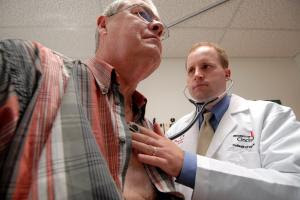
Researchers at the University of Cincinnati (UC) have discovered a protein in the lungs that can help in determining progression of the rare lung disease Idiopathic Pulmonary Fibrosis (IPF).Researchers say the protein—Serum surfactant protein A—is superior to other IPF predictors and could lead to better decisions about treatment and timing of lung transplantation.
The study, led by Brent Kinder, MD, is published in the June 4 edition of the journal Chest.
Surfactant proteins are lipoproteins that allow the lungs to stretch and function. These have previously been investigated by UC pulmonary researchers Frank McCormack, MD, and Jeffrey Whitsett, MD.
Kinder and colleagues report that Serum surfactant protein A is the strongest predictor of a patient's survival in the first year after diagnosis with IPF.
"A simple blood test may give us the information we need to help determine the short term risk of death in a patient with IPF," says Kinder, an assistant professor of medicine at the UC College of Medicine and pulmonologist with UC Physicians. "This protein is a stronger predictor of the severity of illness than age, symptoms or prognostic data, like breathing tests."
IPF is scarring of the lung. As the disease progresses, air sacs in the lungs become replaced by fibrotic scar tissue. Lung tissue becomes thicker where the scarring forms, causing an irreversible loss of the tissue's ability to carry oxygen into the bloodstream.
IPF is one of about 200 disorders called interstitial lung diseases, which affect the thick tissue of the lung as opposed to more common lung ailments—such as asthma or emphysema—that affect the airways.
IPF is the most common form of interstitial lung diseases and affects about 128,000 people in the United States, with an estimated 48,000 new cases diagnosed each year. There currently are no proven therapies or cures for IPF.
Kinder, director of UC's Interstitial Lung Disease Center, says this new indicator will allow doctors to determine the severity of the disease in a fast, effective manner and will help them decide the best way to go about treating it.
"It will allow us to come to a decision about how or if to treat the IPF patient and get them enrolled in clinical trials immediately," he says. "In severe cases, it can help in scheduling a lung transplant at the most optimal time for the patient.
"Overall, this discovery could help us define the window of opportunity to appropriately try more aggressive therapies and could greatly help improve the lives of those living with IPF."
This study was funded in part by a Support of Continuous Research Excellence (SCORE) grant from the National Institutes of Health and a UC Dean's Scholars award for clinical research.
Swine Flu Origins Revealed
Saturday, June 13, 2009 at 7:30 AM Posted by Sajith
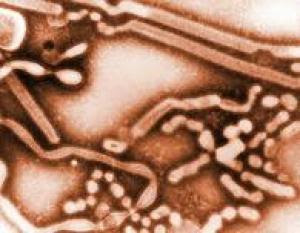
A new analysis of the current swine-origin H1N1 influenza A virus suggests that transmission to humans occurred several months before recognition of the existing outbreak.The work, published online in Nature June 10, highlights the need for systematic surveillance of influenza in swine, and provides evidence that new genetic elements in swine can result in the emergence of viruses with pandemic potential in humans.
'Using computational methods, developed over the last ten years at Oxford, we were able to reconstruct the origins and timescale of this new pandemic,' said Dr Oliver Pybus of Oxford University's Department of Zoology, an author of the paper. 'Our results show that this strain has been circulating among pigs, possibly among multiple continents, for many years prior to its transmission to humans.'
Dr Pybus, along with Andrew Rambaut from the University of Edinburgh and colleagues, used evolutionary analysis to estimate the timescale of the origins and the early development of the epidemic. They believe that it was derived from several viruses circulating in swine, and that the initial transmission to humans occurred several months before recognition of the outbreak.
The team conclude that 'despite widespread influenza surveillance in humans, the lack of systematic swine surveillance allowed for the undetected persistence and evolution of this potentially pandemic strain for many years.'
The team included researchers from Oxford, the University of Edinburgh, the University of Hong Kong and the University of Arizona.
Nintendo Wii May Enhance Parkinson's Treatment
Friday, June 12, 2009 at 9:34 PM Posted by Sajith
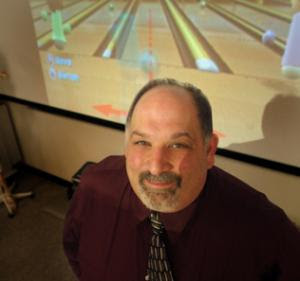
The Nintendo Wii may help treat symptoms of Parkinson's disease, including depression, a Medical College of Georgia researcher says.Parkinson’s disease is a degenerative disease that impairs motor skills. Dr. Herz theorized that the popular computer game console, which simulates various sports and activities, could improve coordination, reflexes and other movement-related skills, but he found additional benefits as well.
"The Wii allows patients to work in a virtual environment that's safe, fun and motivational," says Dr. Ben Herz, program director and assistant professor in the School of Allied Health Sciences Department of Occupational Therapy. "The games require visual perception, eye-hand coordination, figure-ground relationships and sequenced movement, so it's a huge treatment tool from an occupational therapy perspective."
In an eight-week pilot study, 20 Parkinson’s patients spent an hour playing the Wii three times a week for four weeks. The patients, all in a stage of the disease in which both body sides are affected but with no significant gait disturbance yet, played two games each of tennis and bowling and one game of boxing—games entailing exercise, bilateral movement, balance and fast pace.
"By the middle of the study, we actually had a number of people who could [defeat] their opponent out in the first round, which amazed us," says Dr. Herz, who presented his preliminary findings at the fifth annual Games for Health Conference today in Boston.
The victories weren't the biggest surprise, however. Participants showed significant improvements in rigidity, movement, fine motor skills and energy levels. Perhaps most impressively, most participants' depression levels decreased to zero.
An estimated 45 percent of Parkinson’s patients are reported to suffer from depression, though Dr. Herz suspects the actual figure is much higher.
Studies have shown that exercise and video games independently can increase the production of dopamine, a neurotransmitter deficient in Parkinson's patients. He suspects that's the case with the Wii’s exercise effect. Dopamine also helps improve voluntary, functional movements, which Parkinson’s patients "use or lose," Dr. Herz says.
Wii, which features simulated movements such as cracking an egg, swinging a tennis racket and throwing a bowling ball, responds to a player's movements rather than cues from a controller, so players can do full body movements and see their progress on a screen.
"I think we're going to be using virtual reality and games a lot more because it provides a controlled physical environment that allows patients to participate in the activities they need or want to do. A patient doesn't have to go to a bowling alley and worry about environmental problems or distractions," Dr. Herz says.
Dr. Herz's research was funded by a $45,000 grant from the National Parkinson's Foundation. Next he plans to test the Wii Fit balance board with Parkinson's patients and expand his studies to multiple sites.
"Game systems are the future of rehab," Dr. Herz says. "About 60 percent of the study participants decided to buy a Wii for themselves. That speaks volumes for how this made them feel."
Red Wine Compound Resveratrol Demonstrates Significant Health Benefits
at 9:32 PM Posted by Sajith

The benefits of alcohol are all about moderation. Low to moderate drinking – especially of red wine – appears to reduce all causes of mortality, while too much drinking causes multiple organ damage. A mini-review of recent findings on red wine's polyphenols, particularly one called resveratrol, will be published in the September issue of Alcoholism: Clinical & Experimental Research; the review is also available at Early View.Reports on the benefits of red wine are almost two centuries old," said Lindsay Brown, associate professor in the School of Biomedical Sciences at The University of Queensland and corresponding author for the study. "The media developed the more recent story of the French paradox in the early 1990s. However, studies on the actions of resveratrol, one of the active non-alcoholic ingredients, were uncommon until research around 1997 showed prevention of cancers. This led to a dramatic interest in this compound."
Red wine contains a complex mixture of bioactive compounds, including flavonols, monomeric and polymeric flavan-3-ols, highly colored anthocyanins, as well as phenolic acids and the stilbene polyphenol, resveratrol. Brown said that some of these compounds, particularly resveratrol, appear to have health benefits.
"The breadth of benefits is remarkable – cancer prevention, protection of the heart and brain from damage, reducing age-related diseases such as inflammation, reversing diabetes and obesity, and many more," said Brown. "It has long been a question as to how such a simple compound could have these effects but now the puzzle is becoming clearer with the discovery of the pathways, especially the sirtuins, a family of enzymes that regulate the production of cellular components by the nucleus. 'Is resveratrol the only compound with these properties?' This would seem unlikely, with similar effects reported for other components of wine and for other natural products such as curcumin. However, we know much more about resveratrol relative to these other compounds."
Stephen Taylor, professor of pharmacology at the University of Queensland, agreed that resveratrol is the "compound du jour."
"I think that red wine has both some mystique and some historical symbolism in the west," said Taylor, "and of course, some various pleasures attached to its ingestion, all of which give it a psychological advantage edge, food-wise. Not many of us can or will eat a couple of cups of blueberries a day for years on end, but if we could do a population study for a decade or so on such a group, you might actually see similar results."
Key points of the review include:
* Resveratrol exhibits therapeutic potential for cancer chemoprevention as well as cardioprotection.
"It sounds contradictory that a single compound can benefit the heart by preventing damage to cells, yet prevent cancer by causing cell death, said Brown. "The most likely explanation for this, still to be rigorously proved in many organs, is that low concentrations activate survival mechanisms of cells while high concentrations turn on the in-built death signals in these cells."
* Resveratrol may aid in the prevention of age-related disorders, such as neurodegenerative diseases, inflammation, diabetes, and cardiovascular disease.
"The simplest explanation is that resveratrol turns on the cell's own survival pathways, preventing damage to individual cells," said Brown. "Further mechanisms help, including removing very reactive oxidants in the body and improving blood supply to cells."
* Low doses of resveratrol improve cell survival as a mechanism of cardio- and neuro-protection, while high doses increase cell death.
"The key difference is probably the result of activation of the sirtuins in the nucleus," said Brown. "Low activation reverses age-associated changes, while high activation increases the process of apoptosis or programmed cell death to remove cellular debris. Similar changes are seen with low-dose versus high-dose resveratrol: low-dose resveratrol produces cellular protection and reduces damage, while high-dose resveratrol prevents cancers."
In summary, noted Brown, current scientific research is starting to explain reports from the last 200 years that drinking red wine improves health. "It is a cliché that 'nature is a treasure trove of compounds,' but studies with resveratrol show that this is correct! We need to understand better the vast array of compounds that exist in nature, and determine their potential benefits to health."
"There is one particular point that deserves fleshing out," added Taylor. "Resveratrol is largely inactivated by the gut or liver before it reaches the blood stream, where it exerts its effects – whatever they may be – good, bad, or indifferent. Thus, most of the reseveratrol in imbibed red wine does not reach the circulation. Interestingly, absorption via the mucous membanes in the mouth can result in up to around 100 times the blood levels, if done slowly rather than simply gulping it down. Of course, we don't know if these things matter yet, but issues like this are real and generally ignored by all."
BPA Found In Many Plastics May Cause Heart Disease In Women
at 6:55 AM Posted by Sajith

New research by a team of scientists at the University of Cincinnati (UC) shows that bisphenol A (BPA) may be harmful for the heart, particularly in women.Results of several studies are being presented in Washington, D.C., at ENDO 09, the Endocrine Society's annual meeting, June 10-13.
A research team lead by Scott Belcher, PhD, Hong Sheng Wang, PhD, and Jo El Schultz, PhD, in the department of pharmacology and cell biophysics, found that exposure to BPA and/or estrogen causes abnormal activity in hearts of female rats and mice.
In addition, these researchers found that estrogen receptors are responsible for this affect in heart muscle cells.
"There is broad exposure to bisphenol A, despite recognition that BPA can have harmful effects," Belcher says. "We had reason to believe that harmful cardiovascular affects can be added to the list."
BPA, an environmental pollutant with estrogen activity, is used to make hard, clear plastic and is common in many food product containers. It has been linked to neurological defects, diabetes and breast and prostate cancer.
Using live cultures of cells isolated from rat or mouse hearts, researchers briefly exposed the cardiac cells to BPA and/or estrogen. Both compounds caused striking changes in the activity of cardiac muscle cells from females but not males. Additional studies revealed that these cellular changes in activity caused improperly controlled beating in the female heart.
"Low doses of BPA markedly increased the frequency of arrhythmic events," Belcher says. "The effect of BPA on these cardiac arrhythmias was amplified when exposed to estradiol, the major estrogen hormone in humans."
The mechanism underlying this harmful effect was investigated using cellular imaging techniques.
"BPA and/or estrogen rapidly stimulated contraction by altering control of the concentrations of free calcium inside the heart cell but only in heart muscle cells from females, showing that these effects were sex-specific," Belcher says. "BPA's presence increased the frequency of calcium 'sparks' from the sarcoplasmic reticulum—the part of the cardiac muscle that stores and releases calcium ions—indicating spontaneous release or 'leak' that's likely causing the heart arrhythmias and may have other harmful actions, especially following heart attack."
Belcher and colleagues also investigated the nature of the mechanisms that mediated the responses of the cardiac muscle cells to estrogen and BPA.
"Pharmacological studies using selective estrogen receptor drugs and animal models lacking estrogen receptors were used to investigate the role of each estrogen receptor in mediating the rapid sex-specific function effects of E2 and BPA in cells," he says. "Our findings suggest that estrogen has opposing actions in cardiac cells.
"In female cardiac muscle cells, the blocking or genetic removal of estrogen receptor beta completely blocked the contractile effects of BPA and estrogen, while in males, blockade of the effects of estrogen receptor alpha caused the male heart to become more 'female-like' and become responsive to estrogen and BPA.
"These studies have identified new and important potential cardiac risks associated with BPA exposure that may be especially important for women's heart health," he says.
This study was funded by grants from the National Institutes of Health and the UC Center for Environmental Genetics.
WHO Declares Pandemic In Response To Ongoing Global Spread Of Novel Influenza A (H1N1) Virus
at 6:51 AM Posted by Sajith
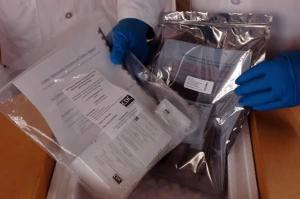
On June 11, 2009, the World Health Organization (WHO) raised the worldwide pandemic alert level to Phase 6 in response to the ongoing global spread of the novel influenza A (H1N1) virus, which causes swine flu. A Phase 6 designation indicates that a global pandemic is underway.More than 70 countries are now reporting cases of human infection with novel H1N1 flu. This number has been increasing over the past few weeks, but many of the cases reportedly had links to travel or were localized outbreaks without community spread. The WHO designation of a pandemic alert Phase 6 reflects the fact that there are now ongoing community level outbreaks in multiple parts of world.
WHO’s decision to raise the pandemic alert level to Phase 6 is a reflection of the spread of the virus, not the severity of illness caused by the virus. It’s uncertain at this time how serious or severe this novel H1N1 pandemic will be in terms of how many people infected will develop serious complications or die from novel H1N1 infection. Experience with this virus so far is limited and influenza is unpredictable. However, because novel H1N1 is a new virus, many people may have little or no immunity against it, and illness may be more severe and widespread as a result. In addition, currently there is no vaccine to protect against novel H1N1 virus.
In the United States, most people who have become ill with the newly declared pandemic virus have recovered without requiring medical treatment, however, CDC anticipates that there will be more cases, more hospitalizations and more deaths associated with this pandemic in the coming days and weeks. In addition, this virus could cause significant illness with associated hospitalizations and deaths in the fall and winter during the U.S. influenza season.
Background
Novel influenza A (H1N1) is a new flu virus of swine origin that first caused illness in Mexico and the United States in March and April, 2009. It’s thought that novel influenza A (H1N1) flu spreads in the same way that regular seasonal influenza viruses spread, mainly through the coughs and sneezes of people who are sick with the virus, but it may also be spread by touching infected objects and then touching your nose or mouth. Novel H1N1 infection has been reported to cause a wide range of flu-like symptoms, including fever, cough, sore throat, body aches, headache, chills and fatigue. In addition, many people also have reported nausea, vomiting and/or diarrhea.
The first novel H1N1 patient in the United States was confirmed by laboratory testing at CDC on April 15, 2009. The second patient was confirmed on April 17, 2009. It was quickly determined that the virus was spreading from person-to-person. On April 22, CDC activated its Emergency Operations Center to better coordinate the public health response. On April 26, 2009, the United States Government declared a public health emergency and has been actively and aggressively implementing the nation’s pandemic response plan.
Since the outbreak was first detected, an increasing number of U.S. states have reported cases of novel H1N1 influenza with associated hospitalizations and deaths. By June 3, 2009, all 50 states in the United States and the District of Columbia and Puerto Rico were reporting cases of novel H1N1 infection. While nationwide U.S. influenza surveillance systems indicate that overall influenza activity is decreasing in the country at this time, novel H1N1 outbreaks are ongoing in parts of the U.S., in some cases with intense activity.
CDC is continuing to watch the situation carefully, to support the public health response and to gather information about this virus and its characteristics. The Southern Hemisphere is just beginning its influenza season and the experience there may provide valuable clues about what may occur in the Northern Hemisphere this fall and winter.
Buckyball Computer Simulations Help Team Find Molecular Key To Combating HIV
Thursday, June 11, 2009 at 7:04 AM Posted by Sajith

Rice University's Andrew Barron and his group, working with labs in Italy, Germany and Greece, have identified specific molecules that could block the means by which HIV -- the deadly virus that causes AIDS -- spreads by taking away its ability to bind with other proteins.Using computer simulations, researchers tested more than 100 carbon fullerene, or C60 ("buckyball"), derivatives initially developed at Rice for other purposes to see if they could be used to inhibit a strain of the virus, HIV-1 PR, by attaching themselves to its binding pocket.
"There are a lot of people doing this kind of research, but it tends to be one group or one pharmaceutical company taking a shotgun approach -- make a molecule and try it out, then make another molecule and try it out," said Barron, Rice's Charles W. Duncan Jr.-Welch Professor of Chemistry and professor of materials science. "This is interesting because we're tackling an important problem in a very rational way."
The groups reported their findings in a paper published on the American Chemical Society's Journal of Chemical Information and Modeling web site last week.
Their method of modeling ways to attack HIV may not be unique, but their collaboration is. Research groups from five institutions -- two in Greece, one in Germany, one in Italy and Barron's group at Rice -- came together through e-mail contacts and conversations over many months, each working on facets of the problem. "Not all the groups have ever met in person," Barron said. Most remarkable, he said, is that their research to date has been completely unfunded.
Using simulations to narrow down a collection of fullerenes to find the good ones is "the least time-consuming low-cost procedure for efficient, rational drug design," the team wrote.
"A long time ago, people noticed that C60 fits perfectly into the hydrophobic pocket in HIV, and it has an inhibition effect," Barron said. "It's not particularly strong, but there's potentially a very strong binding effect. The problem is, it's not the perfect unit." The objective was to find an existing fullerene derivative molecule that could be easily modified to become the perfect unit.
Rice got involved, he said, "because we make the molecules and the other guys had a great method for in-silico testing of molecules. They approached us and said, 'Do you think we could use some of these?' Then we started bouncing ideas around.
"We began thinking about a very simple experiment to calculate the binding efficiency of a molecule in the HIV pocket, then calculate that for a series of molecules, decide which one is best, make that molecule in real life and see if it correlates," Barron said. "If it does, then you've got a way to design your ultimate molecule. Our work was the first step in the process."
In fact, through their "in-silico," or computer-based, calculations, they found two good fits among the fullerene derivatives tested and are now working to enhance their binding properties to get that perfect molecule, one that sticks "like Velcro" to the virus and can be fine-tuned for various strains.
"This is just one component of the problem -- we're not going to cure HIV," Barron cautioned. The hope, he said, is to develop a method for the rapid creation of drugs to address various strains of HIV and other diseases.
Authors of the paper with Barron were Manthos Papadopoulos of the National Hellenic Research Foundation, Athens; Serdar Durdagi of the National Hellenic Research Foundation and the Freie Universitat, Berlin; Claudiu Supuran of the University of Florence, Italy; T. Amanda Strom, Nadjmeh Doostdar and Mananjali Kumar of Rice; and Thomas Mavromoustakos of the National Hellenic Research Foundation and the University of Athens.
The impromptu nature of the project intrigued Barron as much as the subject itself. "Here you've got computational people, experimental people, synthesis people, characterization people who've come together naturally as a collaboration and developed this protocol, developed their own methodologies.
"And no one's paid us to collaborate. Serdar Durdagi’s graduate fellowship was funded by the European Union. The fellowships of Rice graduate students Amanda Strom, Nadjmeh Doostdar and Mananjali Kumar were funded, in part, by Rice's Center for Biological and Environmental Nanotechnology. This is purely an academic collaboration." He said the group is working on a second paper and seeking funding to expand the project.
HIV's March Around Europe Mapped
at 7:00 AM Posted by Sajith

hose travelling abroad should take seriously advice to pack their condoms and keep their needles to themselves. Research published in the open access journal Retrovirology shows that tourists, travellers and migrants from Greece, Portugal, Serbia and Spain actively export HIV-1 subtype B to other European nations.An international team of scientists used samples from 17 European countries to construct a viral phylogeography – a geographic pattern of genetic information taken from viruses at a number of locations that can be used to track how and when it spread (this technique has recently been applied to the bird flu virus H5N1.) HIV-1 subtype B is the most prevalent form of the HIV virus circulating in Europe today.
The results showed that for three countries (Austria, Poland and Luxembourg) no significant exporting migration was observed. Whereas Greece, Portugal, Serbia and Spain were a source of subtype B to other countries. Notably, the virus spread widely from Greece and Spain to seven and five target countries respectively. Other countries had narrower targets, with Italy exporting HIV to Austria, and Portugal passing the virus primarily to Luxembourg (some 13% of Luxembourg's population is Portuguese). Other nations such as Austria, Belgium, Denmark, Germany and Luxembourg showed only limited export of HIV-1 subtype B, while for Italy, Israel, Norway, the Netherlands, Sweden, Switzerland and the UK the authors inferred significant bidirectional migration. For Poland no significant migration was found.
According to the first author, Dimitrios Paraskevis, "Popular tourist destinations like Greece, Portugal and Spain probably spread HIV with tourists infected during their holidays. To a large extent HIV spread within Poland is due to injecting drug users, who make up around half of the HIV-infected population. Viruses move around with travellers – thus health programmes within countries should not only target the national populations, prevention efforts must also be aimed at migrants, travellers and tourists – who are both major sources and targets of HIV."
Soap-sniffing Technology Encourages Hand Washing To Reduce Hospital-acquired Infections, Save Money
Saturday, June 6, 2009 at 3:21 AM Posted by Sajith

Call it a Breathalyzer for the hands. Using sensors capable of detecting drugs in breath, new technology developed at University of Florida monitors health-care workers' hand hygiene by detecting sanitizer or soap fumes given off from their hands.By reminding workers to clean their hands to remove disease-causing organisms such as the bacteria MRSA, the system could help reduce hospital-acquired infections and save millions of dollars now spent to treat them.
The trademarked system, called HyGreen, logs, down to the second, the frequency of hand cleaning and contact with patients in a database that clinical supervisors can review immediately.
This is the first system that enables real-time monitoring of hand washing.
"This isn't big brother, this is just another tool," said Richard J. Melker, M.D., Ph.D., a UF College of Medicine anesthesiology professor who developed the technology along with professors Donn Dennis, M.D., and Nikolaus Gravenstein, M.D., of the anesthesiology department, and Christopher Batich, Ph.D., a materials science professor in the College of Engineering. "A hospital worker never wants to be responsible for someone getting sick or dying from an infection acquired in the hospital."
HyGreen is now being tested in the Neuro Intensive Care Unit at Shands at UF medical center, and will be presented at the annual meeting of the Association for Professionals in Infection Control and Epidemiology June 6 to June 9 in Fort Lauderdale, Fla.
Here's how it works: The health-care worker squirts sanitizer gel or soap into his or her hand before passing it under a wall-mounted sensor. A wireless signal from a badge worn by the worker activates a green light on the hand-washing sensor. When the worker enters a patient room, a monitor near the bed detects the status of the badge, and flashes green if the person has clean hands. If the person has not washed, or too much time has passed between washing and approaching the patient, the badge will give a gentle "reminder" vibration.
"I do wash my hands more often," said nurse Carrie McGirr, R.N., who volunteered to help test the HyGreen system. "It's a fairly simple process to learn."
Close to 2 million hospital-acquired infections occur each year and more than 250 related deaths occur each day in the United States, according to the Centers for Disease Control and Prevention.
"A substantial number of those are preventable, and also one of the key modes of transmission is via the hands of health-care personnel and patients," said Dr. Lennox Archibald, a professor of infectious diseases at the UF College of Medicine, and the Shands at UF epidemiologist leading the evaluation of HyGreen.
Six pathogens, including the ones known as MRSA and VRE, account for two-thirds of all hospital-acquired infections and are readily transmitted by hand.
Studies have shown that up to half of all hospital-acquired infections might be prevented if health-care workers washed their hands according to guidelines set forth by the CDC.
It costs at least $30 billion a year in additional spending to treat hospital-acquired infections. The Center for Medicare and Medicaid Services last year ruled that it would no longer reimburse hospitals for the expense of treating the infections.
Today, more than 160 years after Hungarian physician Ignaz Semmelweiss was ridiculed for suggesting that hand washing by doctors who moved directly from working with cadavers to delivering babies could reduce fatal cases of birth-related infection, the practice still meets with resistance.
"But it's not because people don't want to do it," Archibald said. "It's not inherent in people's behavior to wash their hands, for some reason."
Various studies show that health-care workers wash their hands less than half the time after direct contact with patients. The reasons people give include skin irritation caused by hand hygiene products, a preference for gloves or simply failure to remember.
Previous hand-washing compliance studies have been based on observation of a limited number of people at a time, who likely improve their behavior when they know they are being watched — a phenomenon known as the Hawthorne effect.
"This system is a noninvasive way of measuring — it allows for nonbiased measurement and is unobtrusive," said Loretta Fauerbach, Shands at UF director of infection control, who helped write the CDC hand-washing guidelines and leads the collaboration with HyGreen to evaluate the system in a hospital setting.
"Nobody has ever taken a systems approach to this problem before," said Melker, chief technology officer of Xhale Inc., which is marketing HyGreen.
Developers anticipate that hospitals will readily accept the system because not only can it help reduce infections, it also will pay for itself within a few months.
"Something has to be done about hand washing," Archibald said. "Otherwise the bugs are going to win."
Newly Discovered Reactions From An Old Drug May Lead To New Antibiotics
at 3:13 AM Posted by Sajith

A mineral found at health food stores could be the key to developing a new line of antibiotics for bacteria that commonly cause diarrhea, tooth decay and, in some severe cases, death.The trace mineral selenium is found in a number of proteins in both bacterial cells and human cells called selenoproteins. University of Central Florida Associate Professor William Self's research shows that interrupting the way selenoproteins are made can halt the growth of the super bug Clostridium difficile and Treponema denticola, a major contributor to gum disease.
Infections of Clostridium difficile (commonly known as C-diff) lead to a spectrum of illnesses ranging from severe diarrhea to colitis, which can cause death. It's a life-threatening problem in hospitals and nursing homes worldwide, and the number of cases is on the rise. There are an estimated 500,000 cases per year in the United States alone. Between 15,000 to 20,000 people die each year while infected with this superbug. Treponema denticola is one of leading causes of gum disease and costs individuals thousands of dollars in dental care each year.
Self's findings are published in the May and June editions of the Journal of Biological Inorganic Chemistry and the Journal of Bacteriology. The National Institutes of Health and the Florida Department of Health funded the research, which was conducted at UCF during the past three years.
"It's the proof of principle that we are excited about," Self said from his research lab at UCF. "No one has ever tried this approach, and it could potentially be a source for new narrow spectrum antibiotics that block bacteria that require selenium to grow."
The key discovery occurred when the team found that the gold drug Auranofin, used to treat arthritis, impacted selenium's metabolism process. The chemical reaction changes the selenium, which prevents bacteria from using it to grow. Auranofin is an FDA-approved gold salt compound that is used to control inflammation and is already known to inhibit the activity of certain selenoproteins. Since certain bacteria, such as C. difficile, require selenoproteins for energy metabolism, the drug acts as a potent antimicrobial halting the growth of the bacteria.
The initial studies with C. difficile led to studies with T. denticola, known for several years to require selenium for growth. While testing the gold salt, Self's group also uncovered another surprise; the stannous salts found in many antimicrobial toothpastes in the form of stannous fluoride also inhibited the synthesis of selenoproteins. Previous independent research had already established that stannous salts are more effective at preventing tooth decay and inhibiting growth of T. denticola, but the mechanism of this inhibition of growth was not yet known. These findings could lead to new approaches to preventing gum disease.
"No one has tried to block the metabolism of selenium before as a therapeutic approach," Self said. "That's what's new and exciting and could lead to a whole host of other possibilities, including a better understanding of how the gold salt works for arthritis."
Self said more research is needed, and he already has another grant proposal before the NIH that would move his research forward.
Feeling Close To A Friend Increases Progesterone, Boosts Well-being And Reduces Anxiety And Stress
Thursday, June 4, 2009 at 1:51 AM Posted by Sajith

Why does dishing with a girlfriend do wonders for a woman's mood?
A University of Michigan study has identified a likely reason: feeling emotionally close to a friend increases levels of the hormone progesterone, helping to boost well-being and reduce anxiety and stress.
"This study establishes progesterone as a likely part of the neuroendocrine basis of social bonding in humans," said U-M researcher Stephanie Brown, lead author of an article reporting the study findings, published in the current (June 2009) issue of the peer-reviewed journal Hormones and Behavior.
A sex hormone that fluctuates with the menstrual cycle, progesterone is also present in low levels in post-menopausal women and in men. Earlier research has shown that higher levels of progesterone increase the desire to bond with others, but the current study is the first to show that bonding with others increases levels of progesterone. The study also links these increases to a greater willingness to help other people, even at our own expense.
"It's important to find the links between biological mechanisms and human social behavior," said Brown, is a faculty associate at the U-M Institute for Social Research (ISR) and an assistant professor of internal medicine at the U-M Medical School. She is also affiliated with the Ann Arbor Veterans Affairs Hospital. "These links may help us understand why people in close relationships are happier, healthier, and live longer than those who are socially isolated."
Progesterone is much easier to measure than oxytocin, a hormone linked to trust, pair-bonding and maternal responsiveness in humans and other mammals. Oxytocin can only be measured through an invasive spinal tap or through expensive and complex brain imaging methods, such as positron emission tomography scans. Progesterone can be measured through simple saliva samples and may be related to oxytocin.
In the current study, Brown and colleagues examined the link between interpersonal closeness and salivary progesterone in 160 female college students.
At the start of the study, the researchers measured the levels of progesterone and of the stress hormone cortisol in the women's saliva, and obtained information about their menstrual cycles and whether they were using hormonal contraceptives or other hormonally active medications.
To control for daily variations in hormone levels, all the sessions were held between noon and 7 p.m.
The women were randomly assigned to partners and asked to perform either a task designed to elicit feelings of emotional closeness or a task that was emotionally neutral.
In the emotionally neutral task, the women proofread a botany manuscript together.
After completing the 20-minute tasks, the women played a computerized cooperative card game with their partners, and then had their progesterone and cortisol sampled again.
The progesterone levels of women who had engaged in the emotionally neutral tasks tended to decline, while the progesterone levels of women who engaged in the task designed to elicit closeness either remained the same or increased. The participants' cortisol levels did not change in a similar way.
Participants returned a week later, and played the computerized card game with their original partners again. Then researchers measured their progesterone and cortisol. Researchers also examined links between progesterone levels and how likely participants said they would be to risk their life for their partner.
"During the first phase of the study, we found no evidence of a relationship between progesterone and willingness to sacrifice," Brown said. "But a week later, increased progesterone predicted an increased willingness to say you would risk your life to help your partner."
According to Brown, the findings are consistent with a new evolutionary theory of altruism which argues that the hormonal basis of social bonds enables people to suppress self-interest when necessary in order to promote the well-being of another person, as when taking care of children or helping ailing family members or friends.
The results also help explain why social contact has well-documented health benefits---a relationship first identified nearly 20 years ago by U-M sociologist James House.
"Many of the hormones involved in bonding and helping behavior lead to reductions in stress and anxiety in both humans and other animals. Now we see that higher levels of progesterone may be part of the underlying physiological basis for these effects," Brown said.
Chicken Meat: Organic Acids, Plant Extracts And Irradiation Combine To Beat The Bacteria
Monday, June 1, 2009 at 1:08 AM Posted by Sajith

A mixture of some organic acids and some extracts from plants turns out to be enough to greatly reduce pathogenic bacteria on chicken breast meat. Add some irradiation to the mix and it makes a lethal combination against the bacteria.Food Safety Consortium researchers at the University of Arkansas System’s Division of Agriculture found that they could greatly reduce E. coli O157:H7, Listeria monocytogenes and Salmonella Typhimurium in the chicken breast meat by infusing combinations of organic acids – acetic, citric, lactic, malic and tartaric – into the meat. The experiments were also performed with extracts from green tea and grape seeds in combination with the acids.
Three of the organic acids – malic, citric and tartaric – were most effective against S. Typhimurium and E. coli O157:H7, more than against L. monocytogenes. With irradiation factored in, the results were significant against all the pathogens.
“We want to determine the least amount of plant extracts that we can use and the least amount of irradiation dosage to get the best inhibitory effect,” said Navam Hettiarachchy, a UA food science professor who supervised the project.
Previous research by Hettiarachchy’s research team showed that extracts from grape seed and green tea reduced L. monocytogenes to undetectable levels when applied in combination with nisin, a bacteriocin recognized as a safe food preservative.
The researchers are also using the plant extracts to serve as antioxidants, which minimizes lipid oxidation. Lipid oxidation is a process that causes meat quality to deteriorate by adversely affecting characteristics such as flavor, color and texture.
Hettiarachchy said the research team has examined the effects of irradiation on the chicken’s color and texture and found no significant change.
The research is continuing, but Hettiarachchy said a poultry company has already expressed interest in the project’s findings. Irradiation, however, has not yet been applied widely in the United States as many companies have worried about potential resistance among consumers.
Hettiarachcy suggested that labels on irradiated products could have a brief explanation of irradiation to educate consumers.
“I am hopeful that with time the public will become aware of irradiation processing so that they accept irradiation in processing poultry and meat products for safety against pathogens,” Hettiarachchy said. “A new education component is very important and may be the key for acceptance for irradiated food products by the consumer.”
Search
Labels
- Alzheimer's (10)
- Antibiotics (7)
- Anxiety (1)
- articles (2)
- Bacteria (1)
- behavioral abnormality (1)
- Bio technology (1)
- Brain (8)
- breast cancer (6)
- Cancer (40)
- cancer treatment (7)
- chemotherapy (6)
- Chlamydia (1)
- Cytology (3)
- Death (1)
- Diabetes Mellitus (7)
- Diet (17)
- DNA (1)
- Doctors (1)
- epilepsy (2)
- Fossil (1)
- fruits (1)
- genes (6)
- Genetics (13)
- Geriatrics (1)
- Health (12)
- Heart diseases (9)
- Herbal Medicine (2)
- HIV and AIDS (7)
- influenza (1)
- Inventions (1)
- IVF (1)
- latest findings (1)
- Life style (2)
- Lung Cancer (1)
- Lung Disease (9)
- Microbiology (1)
- Multiple Sclerosis (1)
- Nanotechnology (3)
- Neonatology (1)
- neurology (1)
- News (18)
- Parkinsonism (2)
- Prevention (1)
- Primates (1)
- Prostate cancer (1)
- Prosthetics (1)
- seizure (2)
- Skin (1)
- STD (2)
- Stem cells (9)
- Stroke (1)
- Surgery (2)
- Swine flu (11)
- Virus (1)
- weight loss (1)
Search The Web
Blog Archive
Minyx v2.0 template es un theme creado por Spiga. | Minyx Blogger Template distributed by eBlog Templates

